Content
Onions are a vegetable that no feast is complete without. Bulbs rich in vitamins serve as an excellent seasoning and improve the taste of dishes. The plant is grown everywhere for another reason - its unpretentiousness. However, even such a crop may not ripen well if you do not know when to stop watering the onions.
When to stop watering onions on turnips
The first two months the onion grows very quickly. During this time, the head is formed and the length of the tops increases.

The growing season requires regular but moderate watering
When the turnip just begins to grow, the liquid is spilled between the beds, because if you pour it on the plant, it can wash out the head.
Even if the owner puts the onion back, washing it out can damage the roots - and this is a serious threat to the harvest. After two months, the onion stops actively developing, but continues to collect sucrose and nutrients from the ground. It is during this period that you need to stop watering the onion head.
Signs indicating the end of the growing season are:
- yellowing of the tops;
- drying of scales;
- keeping quality;
- the appearance of dark spots on the bulbs.
You should stop watering around mid-summer. Since ancient times, they stopped pouring water on July 12 - on this day there were festivities in honor of the holy apostles Peter and Paul. Of course, the date is arbitrary.
It is better to rely on external signs and climatic features.In the southern regions, for example, planting begins earlier, which means the harvest is harvested earlier. In the Urals and Siberia, work begins much later.
If the weather is cloudy, the onions ripen even more slowly. In this case, you should definitely stop watering. Due to waterlogging, the bulbs ripen bitter and do not reach the desired size.
If you stop watering the onions too early, it will also not bring any benefit. Beginners are guided by the packaging - it usually indicates when to moisturize and when not to moisturize. In any case, the average period is two months. By that time, the feathers lose chlorophyll, turn yellow and fall to the ground.
It is noteworthy that the head ripens when the owner stops watering. This signals to the culture that it is time to stop developing. If the days are wet, the crop will begin to cycle again. At the same time, the bulbs will produce arrows.

To control moisture levels, gardeners stretch polyethylene
When the season is very hot, on the contrary, the growing season will occur earlier. That is, you need to focus on the feathers - whether they are lying down or not. You can tell when it’s time to stop watering the onions by looking at the condition of the bulbs. They need to be half dug up and inspected. To speed up the ripening process, they are left in the same position without burying.
Half a month after stopping the humidification, you can start cleaning. If you stop watering on time, the material will be resistant to storage. Properly collected bulbs have a brown tint; when removed from the ground, the scales calmly move away. Their feathers are yellow and easily plucked.
When the plant is grown for greens, watering should be stopped four days before cutting. The tops will remain dry and their taste will improve. Humidification can be continued, for example, when the greens are consumed immediately and not stored in the refrigerator - in this case the quality of the feathers will not change.
What happens if you continue watering
If watering is not stopped a few days before harvesting the onions, the outer scales will not have time to form. This will have a bad effect on keeping quality - if stored for a long time, the crop will simply rot. Most likely, the onion will begin to grow again and form feathers. And since the nutrients will have nowhere to come from except from the bulbs themselves, the size of the latter will decrease before our eyes.
Recommendations
Do not neglect the information indicated on the packaging. A variety may have unique characteristics that are different from others. Contrary to the instructions, you should stop watering only when the weather is wet outside.

In the hot season, onions will reach maturity earlier than the planting material manufacturer claims
At low temperatures, ripening may be uneven. In this case, the bulbs and tops are inspected, and the most mature ones are dug out.
Conclusion
When to stop watering onions is usually written on the package of seeds. But the instructions do not take into account the climate and temperature conditions of a particular growing location. The gardener can only rely on the external signs of the onions, and when the heads begin to ripen, stop watering.








